Planet Snapshots
DECEMBER 2, 2021
Issue #4
|
 |
|
PlanetScope image of Lynden, Washington, November 16, 2021.
|
|
In this week’s issue: Floods follow fires in the Pacific Northwest, floating volcanic stones from Japan reach the Philippines, and Formula 1 racers head to Saudi Arabia’s brand new 5G
circuit.
|
|
|
|
|
FEATURE STORY
Come Hell Or High Water
Many ancient myths depict a global apocalypse catalyzed by fire or flood.
And there’s a clear reason why: these two environmental catastrophes often alter landscapes to epic proportions.
Unfortunately, myth is becoming reality for many places in the world as climate disasters converge and compound with increasing magnitude and intensifying frequency.
|
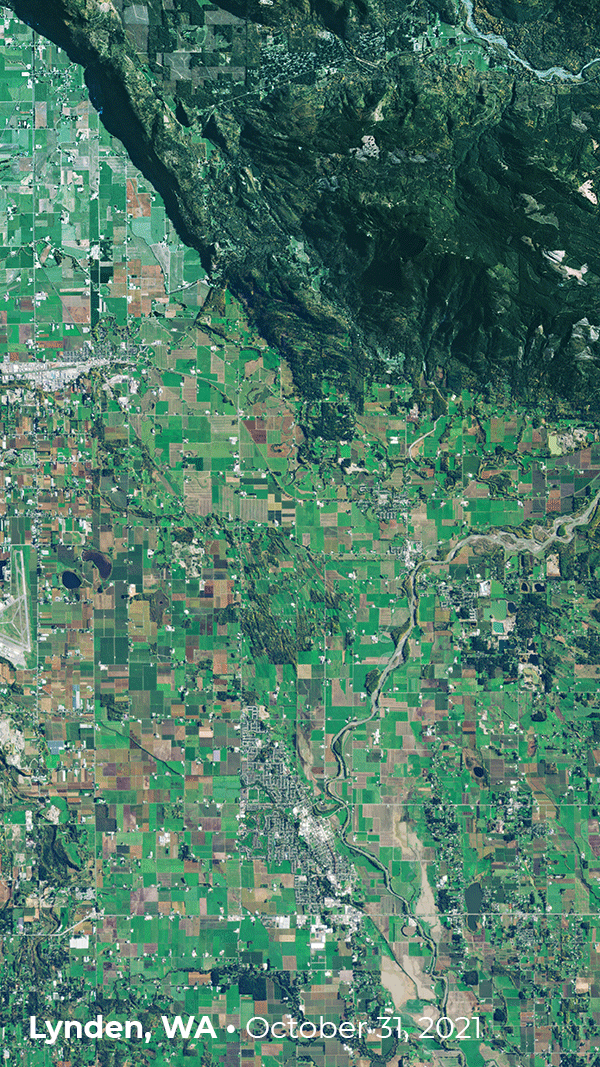 |
|
PlanetScope images of Lynden, Washington.
|
|
A heat dome scorched the Pacific Northwest earlier this summer, setting record temperature levels and contributing to one of the region’s worst wildfire seasons in history with nearly 1.5 million acres burned in Washington and Oregon.
In Lytton, British Columbia, the fires were so fierce and fast that they destroyed 90% of the small town within hours.
We’ve observed these tragic events with concern and are helping local authorities prepare, monitor, and subdue their impact.
|
 |
|
SkySat image of Lytton, British Columbia, Canada, July 2, 2021.
|
|
As the seasons progress in the Pacific Northwest, so too do the climate threats.
Unprecedentedly high temperatures over the summer have turned to once-in-a-century rainfall in November as an atmospheric river dumped a month’s worth of
rain in just 2 days.
Satellite images show the extent of this destruction, as brown water covers low-lying regions of the landscape.
|
 |
|
SkySat images of Abbotsford, British Columbia, Canada.
|
|
The near-foot of rain closed major transportation routes, displaced tens of thousands of people, and caused untold destruction.
The rains precipitated mudslides that were made worse by soil loosened from the summer’s fires.
In British Columbia, the flooding closed rail services in and out of Vancouver, further constricting supply chains amidst problems for the global transportation of goods.
|
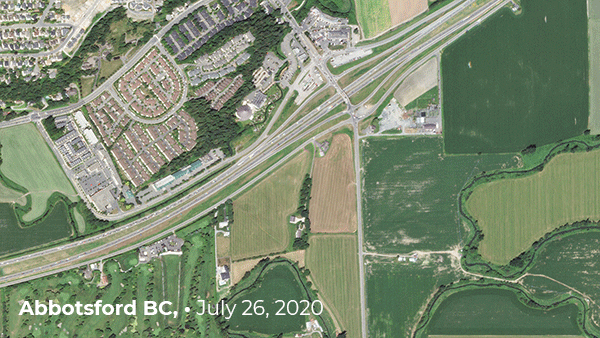 |
|
SkySat images of Abbotsford, British Columbia, Canada.
|
|
It’s difficult—possibly impossible—to write about cycles of disaster linearly.
Interconnected events don’t follow a clear cause and effect progression.
In the climate crisis, disasters compound and build upon each other.
When we observe one climate event, we are also seeing the multitude of preceding ones and the groundwork being laid for the next series.
|
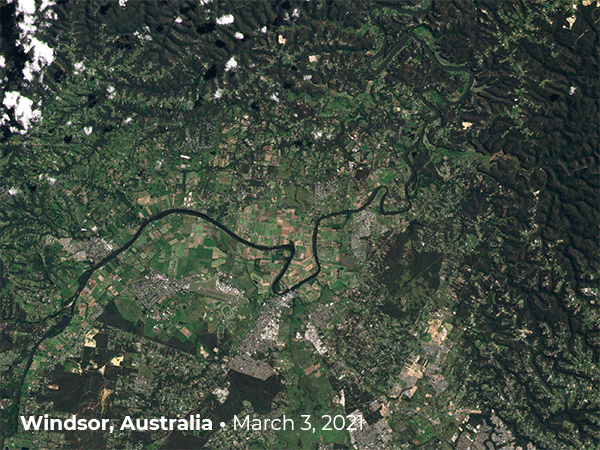 |
|
PlanetScope images of Windsor, Australia.
|
|
|
|
|
|
|
|
|
|
PlanetScope image of Batan and Sabtang Islands, Philippines, November 22, 2021.
|
|
Maybe you have a large pumice stone floating in your bathtub, but you definitely can’t see it from space.
On November 21, residents of the Batanes archipelago in the Philippines spotted masses of pumice (those grey trails in the ocean) floating between the islands of Batane (upper right) and Sabtang (lower left).
Pumice is a form of porous volcanic rock that forms when lava is cooled before it can crystallize.
Because it’s filled with gas bubbles, it’s very light and can float in water, moving with the ocean’s currents for months at a time.
The pumice spotted here traveled 2,060 km (1,280 miles) from Fukutoku-Okanoba, an underwater volcano in Japan, that erupted months ago.
In fact, we spotted that pumice trail forming back in August after a volcanic eruption broke the ocean’s surface and formed a new island.
|
|
|
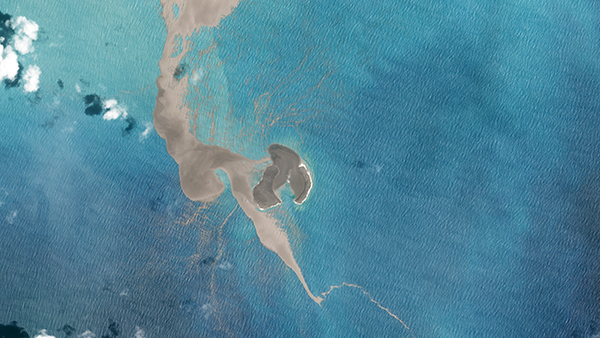 |
|
PlanetScope image of Fukutoku-Okanoba, Japan, August 15, 2021.
|
|
|
|
|
5G Formula Circuit on the Red Sea
|
 |
|
SkySat image of Jeddah Corniche Circuit, Jeddah, Saudi Arabia, November 21, 2021.
|
|
“It’s lights out and away we go!” Formula 1 racers are heading to Saudi Arabia’s Jeddah Corniche Circuit this weekend for the country’s inaugural Grand Prix on December 5th.
The newly-constructed 6.174 km track is the fastest street circuit ever built.
Cars are estimated to reach top speeds of 322 kmh (200 mph) as they race through
27 corners in the penultimate round of the season.
As the drivers battle head to head, spectators will be closer to the action than ever before as they connect their devices to the circuit’s 5G network.
|
|
|
|
|
Image Highlight: Overview
|
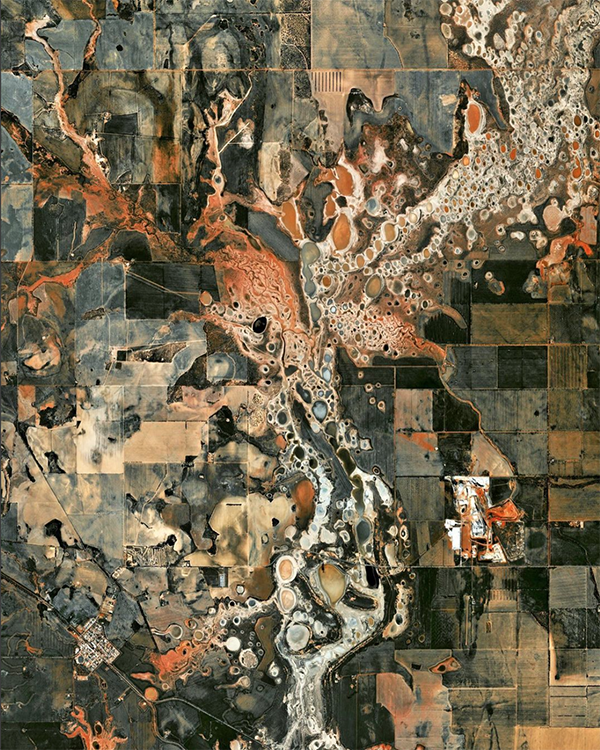 |
|
Created by Overview, source imagery from Planet.
|
|
Repost from @dailyoverview: “The Yarra Yarra Lakes Nature Reserve is a system of small salt lakes near the town of Carnamah, Western Australia.
Once the site of a great river, this landscape has formed due to changes in land and sea level, a drier climate, and infrequent rains.
Lakes here will change color throughout the year, turning blue in the winter as they fill with water and pink in the summer as they evaporate and leave behind salt.”
|
|
|
|
|